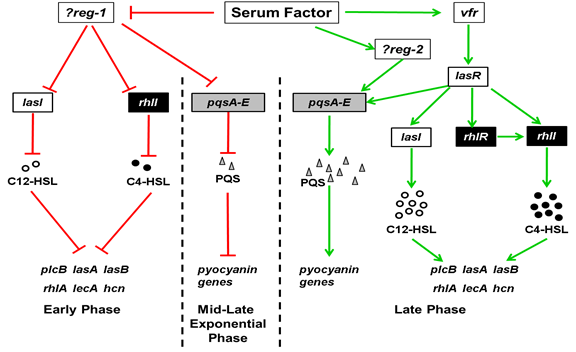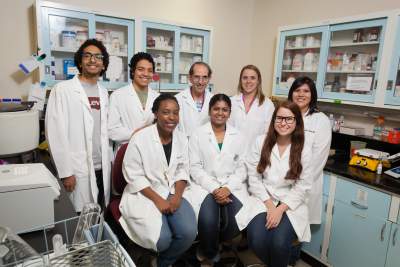Abdul Hamood, PhD

Abdul Hamood, Ph.D.
Professor
E-mail: abdul.hamood@ttuhsc.edu
Phone: 806-743-4057
Education:
Postdoctoral Fellow: University of Rochester, School of Medicine, 1990
PhD: University of Missouri Columbia, 1985
Research Interests:

Diagram illustrating the possible mechanisms described through which serum represses and then enhances the expression of PAO1 QS and QS-controlled virulence genes. The specific gene(s) through which serum represses the QS systems at early and mid-late exponential phases is not yet known (?reg-1). Low levels of auto-inducers (C12-HSL, C4-HSL, and PQS) are insufficient to activate LasR, RhlR, and MvfR with subsequent reduction in QS-related gene expression. At the late phase of growth, the serum factor enhances vfr expression, which enhances LasR expression with subsequent enhancement of C12-HSL, C4-HSL, and PQS synthesis leading to increased expression of QS-related genes. Additionally, the serum factor may enhance the expression of another yet unknown regulatory gene (?reg-2) that affects expression of pqsA-E. ──|, indicates repression of gene expression; , indicates enhancement of gene expression. Experimental evidence showed that the QS regulatory genes VqsR, rsmA, MvaT, gacA, and rpoN were not involved in this regulatory process.
Current and Former Students & Postdocs:
Current Students:
- Nyaradzo Dzvova: graduate student. Her research project involves analyzing a novel Pseudomonas aeruginosa gene that plays a critical role during P. aeruginosa sepsis
- Kayla Bounds: Graduate student. Her project involves analyzing the host response during injury and treatment with the novel antimicrobial agent, Next Science.
- Taylor Letbetter: Graduate student. Her project involves analyzing the potential antimicrobial effect within the supernatant of Lactobacilli.
- Moamen El-Masry: graduate student. His project involves analyzing transcriptome changes in Pseudomonas aeruginosa during its growth in blood from trauma patients.
- Kellsie Beasley: Graduate student. Her project involves transcriptome analysis of Pseudomonas aeruginosa strains PAO1 and PA14 during their growth in blood. This includes a detailed analysis of the phenazine operons.
- Nithya Mudaliar, MS.: Research associate. She helps overseeing different projects. Her specific project is the development of a serum therapy for severely burned patients using the type three secretion system as a target
- Kelsey Sprinkle: undergraduate student. Her project involves assessing the inhibitory effects of different lactobacilli on selected wound pathogens.
- Cecily Elliott: undergraduate student/Honors College. Her project includes evaluation of the Pseudomonas aeruginosa pyocin as a potential antimicrobial agent.
- Jair Montford: Volunteer. His project involves comparing biofilm formation and the growth of Gardnerella vaginalis. This includes studying the attachment of G. vaginalis to the host cells.
- Stephany Navarro: Student.Her project involves assessing the effectiveness of coated catheters in inhibiting the growth of pathogenic bacteria.
Former Graduate Students and Postdoctoral Fellows:
- McVay, Catherine, PhD. 1995
Associate Professor, University of Alabama - Colmer, Jane, PhD. 1997

Associate Professor, Department of Medical Education, TTUHSC
Swanson, Britta, PhD. 2000 - Rumbaugh, Kendra, PhD. 2001
Associate Professor, Department of Surgery, TTUHSC - Carty, Nancy, PhD. 2002
Associate Professor, Department of Microbiology, Lake Erie College Osteopathic Medicine - Schaber, James A. (Andy), PhD. 2006
Imaging Facility Director, Bioscience Imaging facility, Purdue University Principal - Westfall, Landon, PhD. 2006
Associate Research Scientist, Lovelace Respiratory Research Institute, Birmingham, AL. - Gaines, Jennifer, PhD, 2006

- Kruczek, Cassandra, PhD, 2013
Assistant Professor, Department of Medical Education, TTUHSC - Haley, Cecily, PhD, 2013
Teacher, J. Frank Dobie High School, Houston, TX. - Balyimez, Aysegul, PhD, 2013
Auten, Jena Claire, PhD, 2014
Science teacher, Carroll High School, Southlake, Texas - Wang, James, PhD, 2014
Resident Physician, University of Cincinnati, College of Medicine - Dzvova, Nyaradzo, PhD, 2014-
- Bounds, Kayla, PhD, 2016-
Selected Publications
- Miller KG, Tran PL, Haley CL, Kruzek C, Colmer-Hamood JA, Myntti M, Hamood AN. 2014. Next Science Wound Gel Technology, a Novel Agent That Inhibits Biofilm Development by Gram-Positive and Gram-Negative Wound Pathogens. Antimicrob Agents Chemother. 58(6):3060-3072.
- Kruczek C, Qaisar U, Colmer-Hamood JA, Hamood AN. 2014. Serum influences the expression of Pseudomonas aeruginosa quorum-sensing genes and QS-controlled virulence genes during early and late stages of growth. MicrobiologyOpen.. 3(1):64-79
- Tran PL, Hamood AN, de Souza A, Schultz G, Liesenfeld B, Mehta D, Reid TW. 2015. A study on the ability of quaternary ammonium groups attached to a polyurethane foam wound dressing to inhibit bacterial attachment and biofilm formation. Wound Repair Regen. 23(1):74-81
- Kruczek C, Kottapalli KR, Dissanaike S, Dzvovz N, Griswold JA, Colmer-Hamood JA, Hamood AN. 2016. Major transcriptome changes accompany the growth of Pseudomonas aeruginosa in blood from patients with severe thermal injuries. PLoS One.11(3):e0149229
- Qaisar U, Kruczek CJ, Azeem M, Javaid N, Colmer-Hamood JA, Hamood AN. 2016. The Pseudomonas aeruginosa extracellular secondary metabolite, Paerucumarin, chelates iron and is not localized to extracellular membrane vesicles. J Microbiol. 54(8):573-581
- Colmer-Hamood JA, Dzvova N, Kruczek C, Hamood AN. 2016. In Vitro Analysis of Pseudomonas aeruginosa Virulence Using Conditions That Mimic the Environment at Specific Infection Sites. Prog Mol Biol Transl Sci.142:151-191.
- Wang J, Cordero J, Sun Y, Aranke M, Wolcott R, Colmer-Hamood J, and Hamood A. Planktonic Growth of Pseudomonas aeruginosa Around a Dual-Species Biofilm Supports the Growth of Fusobacterium nucleatum within that Biofilm. International Journal of Otolaryngology (in press)
